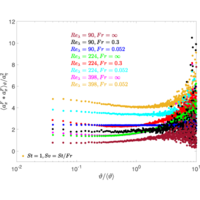当前位置:
X-MOL 学术
›
Phys. Rev. Fluids
›
论文详情
Our official English website, www.x-mol.net, welcomes your
feedback! (Note: you will need to create a separate account there.)
Local analysis of the clustering, velocities, and accelerations of particles settling in turbulence
Physical Review Fluids ( IF 2.5 ) Pub Date : 2020-03-20 , DOI: 10.1103/physrevfluids.5.034306 Mohammadreza Momenifar , Andrew D. Bragg
Physical Review Fluids ( IF 2.5 ) Pub Date : 2020-03-20 , DOI: 10.1103/physrevfluids.5.034306 Mohammadreza Momenifar , Andrew D. Bragg

|
Using three-dimensional Voronoi analysis, we explore the local dynamics of small, settling, inertial particles in isotropic turbulence using direct numerical simulations. We independently vary the Taylor Reynolds number , Froude number (where is the Kolmogorov acceleration, and is the acceleration due to gravity), and Kolmogorov scale Stokes number . In agreement with previous results using global measures of particle clustering, such as the radial distribution function, we find that for small Voronoi volumes (corresponding to the most clustered particles), the behavior is strongly dependent upon St and Fr, but only weakly dependent upon , unless . However, larger Voronoi volumes (void regions) exhibit a much stronger dependence on , even when , and we show that this, rather than the behavior at small volumes, is the cause of the sensitivity of the standard deviation of the Voronoi volumes that has been previously reported. We also show that the largest contribution to the particle settling velocities is associated with increasingly larger Voronoi volumes as the settling parameter is increased. Our local analysis of the acceleration statistics of settling inertial particles shows that clustered particles experience a net acceleration in the direction of gravity, while particles in void regions experience the opposite. The particle acceleration variance, however, is a convex function of the Voronoi volumes, with or without gravity, which seems to indicate a nontrivial relationship between the Voronoi volumes and the sizes of the turbulent flow scales. Results for the variance of the fluid acceleration at the inertial particle positions are of the order of the square of the Kolmogorov acceleration and depend only weakly on Voronoi volumes. These results call into question the “sweep-stick” mechanism for particle clustering in turbulence which would lead one to expect that clustered particles reside in the special regions where the fluid acceleration is zero (or at least small). We then consider the properties of particles in clusters, which are regions of connected Voronoi cells whose volume is less than a certain threshold. The results show self-similarity of the clusters, and that the statistics of the cluster volumes depends only weakly on St, with a stronger dependence on Fr and . Finally, we compare the average settling velocities of all particles in the flow with those in clusters, and show that those in the clusters settle much faster, in agreement with previous work. However, we also find that this difference grows significantly with increasing and exhibits a nonmonotonic dependence on Fr. The kinetic energy of the particles, however, is almost the same for particles whether or not they are in clusters.
中文翻译:

对湍流中沉降颗粒的聚集,速度和加速度的局部分析
使用三维Voronoi分析,我们使用直接数值模拟探索了各向同性湍流中小的,沉降的惯性粒子的局部动力学。我们独立更改泰勒·雷诺兹数,弗洛伊德数 (哪里 是Kolmogorov加速度,并且 是由于重力引起的加速度),以及Kolmogorov比例斯托克斯数 。与先前使用整体粒子聚类测度(例如径向分布函数)的结果一致,我们发现对于较小的Voronoi体积(对应于最聚类的粒子),其行为强烈依赖于St和Fr,但仅弱依赖于,除非 。但是,较大的Voronoi体积(无效区域)表现出更强的依赖性,即使 ,这表明,而不是小体积的行为,是导致先前报道的Voronoi体积标准偏差敏感的原因。我们还表明,对粒子沉降速度的最大贡献与越来越大的Voronoi体积作为沉降参数有关增加。我们对沉降惯性粒子的加速度统计数据的本地分析表明,聚集的粒子在重力方向上经历了净加速度,而在空隙区域中的粒子则经历了相反的加速度。但是,无论有无重力,粒子加速度方差都是Voronoi体积的凸函数,这似乎表明Voronoi体积与湍流尺度的大小之间具有非平凡的关系。惯性粒子位置的流体加速度方差的结果约为Kolmogorov加速度的平方,并且仅微弱地取决于Voronoi体积。这些结果使人们对湍流中的粒子聚类的“摇杆”机制提出了质疑,这种机制会使人们期望聚类的粒子驻留在流体加速度为零(或至少很小)的特殊区域中。然后,我们考虑簇中颗粒的属性,簇是连接的Voronoi细胞的区域,其体积小于某个阈值。结果表明,聚类具有自相似性,聚类量的统计量仅弱依赖于St,而对Fr和。最后,我们将流中所有粒子的平均沉降速度与团簇中的平均沉降速度进行了比较,结果表明,与先前的工作一致,团簇中的粒子沉降得更快。但是,我们还发现,这种差异会随着并且表现出对Fr的非单调依赖性。但是,无论颗粒是否成簇,颗粒的动能几乎相同。
更新日期:2020-03-20
中文翻译:

对湍流中沉降颗粒的聚集,速度和加速度的局部分析
使用三维Voronoi分析,我们使用直接数值模拟探索了各向同性湍流中小的,沉降的惯性粒子的局部动力学。我们独立更改泰勒·雷诺兹数,弗洛伊德数 (哪里 是Kolmogorov加速度,并且 是由于重力引起的加速度),以及Kolmogorov比例斯托克斯数 。与先前使用整体粒子聚类测度(例如径向分布函数)的结果一致,我们发现对于较小的Voronoi体积(对应于最聚类的粒子),其行为强烈依赖于St和Fr,但仅弱依赖于,除非 。但是,较大的Voronoi体积(无效区域)表现出更强的依赖性,即使 ,这表明,而不是小体积的行为,是导致先前报道的Voronoi体积标准偏差敏感的原因。我们还表明,对粒子沉降速度的最大贡献与越来越大的Voronoi体积作为沉降参数有关增加。我们对沉降惯性粒子的加速度统计数据的本地分析表明,聚集的粒子在重力方向上经历了净加速度,而在空隙区域中的粒子则经历了相反的加速度。但是,无论有无重力,粒子加速度方差都是Voronoi体积的凸函数,这似乎表明Voronoi体积与湍流尺度的大小之间具有非平凡的关系。惯性粒子位置的流体加速度方差的结果约为Kolmogorov加速度的平方,并且仅微弱地取决于Voronoi体积。这些结果使人们对湍流中的粒子聚类的“摇杆”机制提出了质疑,这种机制会使人们期望聚类的粒子驻留在流体加速度为零(或至少很小)的特殊区域中。然后,我们考虑簇中颗粒的属性,簇是连接的Voronoi细胞的区域,其体积小于某个阈值。结果表明,聚类具有自相似性,聚类量的统计量仅弱依赖于St,而对Fr和。最后,我们将流中所有粒子的平均沉降速度与团簇中的平均沉降速度进行了比较,结果表明,与先前的工作一致,团簇中的粒子沉降得更快。但是,我们还发现,这种差异会随着并且表现出对Fr的非单调依赖性。但是,无论颗粒是否成簇,颗粒的动能几乎相同。











































 京公网安备 11010802027423号
京公网安备 11010802027423号